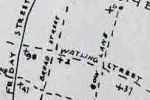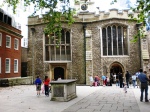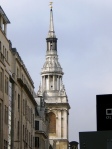Folk knowledge and old secrets, often garbled and no longer understood, can sometimes still be found in such apparently innocent repositories as fairy tales and children’s songs.
In “The Secret Fire”, the song ‘Oranges and Lemons’, its true meaning long forgotten, is said by the novel’s main villain, Isambard, to encode a great London secret — the location of the mighty artery of power that is the city’s main ley line.
(Click here to view the London or “St Paul’s” ley line in Google Maps)
Beyond the short version of the song used in the popular children’s party game, there is also a longer, older version, listing more churches, that contains the secret.
It has been hidden in plain sight through the ages, but can be decoded — as long as the right churches are understood, for they are not always the traditional ones.
Following is the full version of the song, with the significance of each line explained by Isambard:
Gay go up and gay go down, to ring the bells of London Town. “This is simply the preamble, and might be held to have no secret meaning, except that ringing the bell of a sacred location is an expression we use to signify tapping into its power.”
 Oranges and lemons, say the bells of St Clement’s. “This is commonly held to refer to St Clement’s church in Eastcheap, near wharves where fruit was loaded from the ships in past times. But in our reading, its reference is to the church of St Clement Danes, a central point on London’s artery of power, located among a cluster of holy wells.”
Oranges and lemons, say the bells of St Clement’s. “This is commonly held to refer to St Clement’s church in Eastcheap, near wharves where fruit was loaded from the ships in past times. But in our reading, its reference is to the church of St Clement Danes, a central point on London’s artery of power, located among a cluster of holy wells.”
Bullseyes and targets, say the bells of St Margaret’s. “This refers to the church of St Margaret Lothbury, just north of the site of the Bank of England on Cornhill, and just to the north of our line.”
Brickbats and tiles, say the bells of St Giles. The inclusion of the phrase St Giles, in the fourth line, is a reference to St Giles’s Greek, a term for thieves’ cant or slang. It tells us that a special language is being used in this song, one where the ostensible term does not necessarily represent the real meaning. It’s like reading the words and illustrations of an alchemical book. Having noticed the presence of the phrase, we can discard it. It does not refer to any of the St Giles churches in London, it is merely a marker. For the uninstructed, of course, it serves simply to confuse the pattern.”
Ha’pence and farthin’s, say the bells of St Martin’s. “In our reading, this is St Martin-within-Ludgate on Ludgate Hill, again just above our line, setting its northern limit. The font here is engraved with a fascinating palindrome in Greek: Niyon anomhma mh monan oyin. Cleanse my sin and not just my face.”
Pancakes and fritters, say the bells of St Peter’s. “This is St Peter upon Cornhill, which claims to be the earliest Christianized site in Britain, just below our line, framing it to the south.” An alternative site would be St Peter in West Cheap, just to the north of the line.
Two sticks and an apple, say the bells of Whitechapel. “This refers not to a particular church, but to the famed bell foundry of Whitechapel in general, and so to the principle of bells, of harmonic resonance, and so to our unnamed art. It does not appear on our map.”
Maids in white aprons, say the bells of St Katherine’s. “St Katherine Cree in Bishopsgate, just south of our line.”
Pokers and tongs, say the bells of St John’s. “St John the Evangelist, formerly on Friday Street, destroyed in the Great Fire of 1666. Just south of our line.”
 Kettles and pans, say the bells of St Anne’s. “This marks the continuation of our line to the west, and refers to St Anne’s in Soho. It sits squarely on our line.”
Kettles and pans, say the bells of St Anne’s. “This marks the continuation of our line to the west, and refers to St Anne’s in Soho. It sits squarely on our line.”
Old father baldpate, say the slow bells of Aldgate. “St Botolph-without-Aldgate, just south of our line in the east.”
You owe me ten shillin’s, say the bells of St Helen’s. “St Helen’s Bishopsgate, directly on our line in the east.”
When will you pay me, say the bells of Old Bailey. “The reference here is to the death knell rung at the church of St Sepulchre, and later at the Old Bailey itself on its own bell, on days of public execution. Apparently an outlying marker, north of our line. For this reason, we consider it in the symbolic sense. The wages of sin is death, is perhaps the best summary, where sin is understood to be the misuse of the power of the line.”
 When I grow rich, say the bells of Fleetditch. “This was later altered to Shoreditch, but in the earlier versions the song said Fleetditch, referring to St Bride’s church, on the banks of the River Fleet before it was culverted. St Bride’s is directly on our line.”
When I grow rich, say the bells of Fleetditch. “This was later altered to Shoreditch, but in the earlier versions the song said Fleetditch, referring to St Bride’s church, on the banks of the River Fleet before it was culverted. St Bride’s is directly on our line.”
Pray when will that be, say the bells of Stepney. “St Dunstan’s, in Stepney, directly on the continuation of our line to the east, and mirroring St Dunstan-in-the-west on Fleet Street, situated just north of our line.”
I do not know, says the great bell of Bow. “St Mary-le-Bow on Cheapside, the church all true Cockneys are said to identify themselves by. Directly on our path.”
 Although not mentioned in the nursery rhyme, several other churches, or the sites of former churches, lie along the line, including of course St Paul’s Cathedral and the round Temple church.
Although not mentioned in the nursery rhyme, several other churches, or the sites of former churches, lie along the line, including of course St Paul’s Cathedral and the round Temple church.
The great artery also runs directly along a stretch of Pilgrim Street near St Paul’s, and is marked by an intriguingly-located obelisk at Salisbury Square just west of St Bride’s (moved there in the late 20th century from nearby Ludgate Circus). On its western arm, it passes just below the twin obelisks outside St George’s church and traverses Sotheby’s auction house before bisecting Grosvenor Square and running on to the point formerly called Bayard’s Watering Place, now known as the Italian Gardens, where the buried Westbourne river enters Hyde Park.
In Sir Christopher Wren’s plan to rebuild London after the Great Fire of 1666, the eastern part of this line, from St Helen’s to Temple, was virtually a single, straight boulevard, a grand avenue along the great London line of power …
What did he know?




Thanks, I find this most interesting.